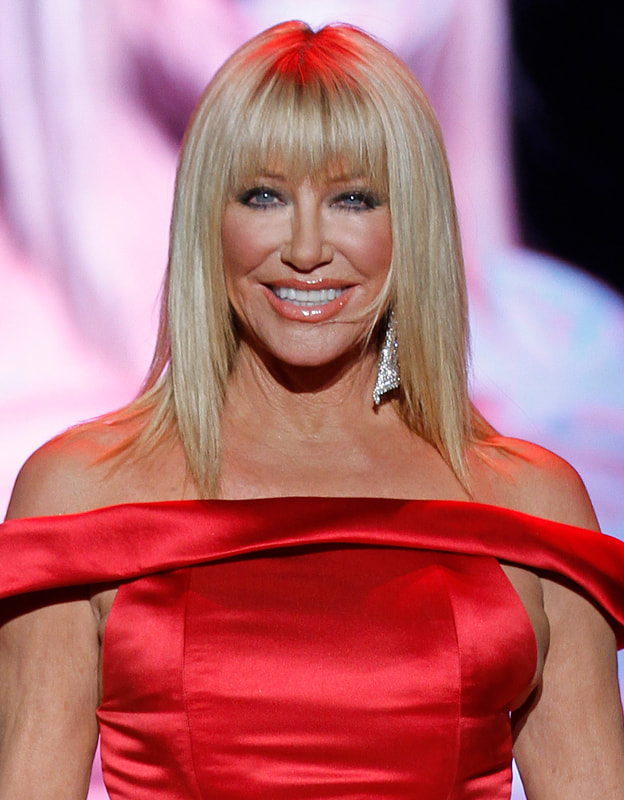"In the 1970s we marched in the streets for equal pay and equal rights. Women’s careers were ruined for asking to be paid what they deserved, and they hoped that soon, this would be a distant memory. Today, women, nonbinary, and transgender people are still paid less than cis men."
- Zoe Mastropasqua 11th grade
On October 15th, 2023, Suzanne Somers, one of the stars of the hit 1970s show Three’s Company, passed away from breast cancer. This has brought an outpour of tributes from friends and fans alike expressing their grief over the star's passing, with stars like Fran Drescher expressing their condolences and describing Somers as a “sweet & talented woman” and numerous fans posting tributes on social media. It has also reopened questions about why she left Three’s Company in its fifth season.
Three’s Company was a show about two women and a man who live together above their landlords, and hilarity ensues. The show also stars Joyce DeWitt and John Ritter. The troubles began because DeWitt and Somers’ salary was one-fifth of what John Ritter made per episode. When Somers went to the show runners to ask for equal pay she was fired. From then on Somers’ public persona went from a bubbly girl next door to a stuck-up, greedy actress, ruining her career.
Tensions against Somers were so high, according to an article in Biography, that during her last season, she had to be escorted to and from the set by police. Her Widower, Alan Hamel, stated that Somers had been made an example of to discourage other women from fighting for equal pay. Somers herself said the show runners "painted me as she's trying to ruin the show, and so the whole show -- cast and crew -- shunned me."
Three’s Company was a show about two women and a man who live together above their landlords, and hilarity ensues. The show also stars Joyce DeWitt and John Ritter. The troubles began because DeWitt and Somers’ salary was one-fifth of what John Ritter made per episode. When Somers went to the show runners to ask for equal pay she was fired. From then on Somers’ public persona went from a bubbly girl next door to a stuck-up, greedy actress, ruining her career.
Tensions against Somers were so high, according to an article in Biography, that during her last season, she had to be escorted to and from the set by police. Her Widower, Alan Hamel, stated that Somers had been made an example of to discourage other women from fighting for equal pay. Somers herself said the show runners "painted me as she's trying to ruin the show, and so the whole show -- cast and crew -- shunned me."
Fans of the Show even to this day hold a grudge against Somers, feeling like she thought she was too good for the show, with one fan on Quora stating, “No one wanted to hire a no-talent b*tch with a minimal resume and an ego the size of alpha centauri.” They went on to discredit her career and talent as an actress saying "her claim to fame was showing her t*ts and getting shot in the swimming pool in the Dirty Harry movie.” It shouldn’t have mattered if she was fully nude, painted blue, and launched out of a canon. In a show where she was doing as much work as her male counterpart, she should have been paid equally.
Unfortunately, Somers’ story is not a unique one. In the 1960s and 70s, “the female-to-male earnings ratio was stagnant, hovering between 57 to 61 cents to the dollar of male earnings,” as stated in an article by The Government Census website. For her performance in The Wizard of Oz, Judy Garland was paid 500 dollars a week, while her male co-stars were paid 3,000 dollars per week.
Although not quite as bad, we see examples of this even now. In her 2022 movie Don’t Worry Darling, Florence Pugh, a renowned actress, was paid $700,000 as the lead. Harry Styles, who had only two previous screen credits, was paid around 2.5 million dollars.
The pay gap isn’t only apparent in show business. Although Google has many claims about striving for equality and takes great pride in their D&I, (Diversity and Inclusion) an article by Tech Co reveals that Google has an enormous gender wage gap. “the average female staff member earning a base salary of $165,000 compared to their male counterpart earning $172,500…those who identified as neither male or male (so transgender and non-binary Googlers) earned less still, with average base pay of $154,070.” According to the Economic Policy Institute, women were, on average, paid 20.3% less than men in 2019. By 2022, that gap widened to 22.2.
In the 1970s we marched in the streets for equal pay and equal rights. Women’s careers were ruined for asking to be paid what they deserved, and they hoped that soon, this would be a distant memory. Today, women, nonbinary, and transgender people are still paid less than cis men.
Suzanne Somers’ death, though tragic in its own right, has provided an opportunity to look back in time at the wage gap to show us we haven't made much progress. She lived in a world where she made significantly less than her male counterparts and was fired when she tried to negotiate, and that world hasn’t changed much. Instead, companies throw a veil of fake equality and progressiveness over themselves to cover that they still have a long way to go in the fight for equality.
Unfortunately, Somers’ story is not a unique one. In the 1960s and 70s, “the female-to-male earnings ratio was stagnant, hovering between 57 to 61 cents to the dollar of male earnings,” as stated in an article by The Government Census website. For her performance in The Wizard of Oz, Judy Garland was paid 500 dollars a week, while her male co-stars were paid 3,000 dollars per week.
Although not quite as bad, we see examples of this even now. In her 2022 movie Don’t Worry Darling, Florence Pugh, a renowned actress, was paid $700,000 as the lead. Harry Styles, who had only two previous screen credits, was paid around 2.5 million dollars.
The pay gap isn’t only apparent in show business. Although Google has many claims about striving for equality and takes great pride in their D&I, (Diversity and Inclusion) an article by Tech Co reveals that Google has an enormous gender wage gap. “the average female staff member earning a base salary of $165,000 compared to their male counterpart earning $172,500…those who identified as neither male or male (so transgender and non-binary Googlers) earned less still, with average base pay of $154,070.” According to the Economic Policy Institute, women were, on average, paid 20.3% less than men in 2019. By 2022, that gap widened to 22.2.
In the 1970s we marched in the streets for equal pay and equal rights. Women’s careers were ruined for asking to be paid what they deserved, and they hoped that soon, this would be a distant memory. Today, women, nonbinary, and transgender people are still paid less than cis men.
Suzanne Somers’ death, though tragic in its own right, has provided an opportunity to look back in time at the wage gap to show us we haven't made much progress. She lived in a world where she made significantly less than her male counterparts and was fired when she tried to negotiate, and that world hasn’t changed much. Instead, companies throw a veil of fake equality and progressiveness over themselves to cover that they still have a long way to go in the fight for equality.



